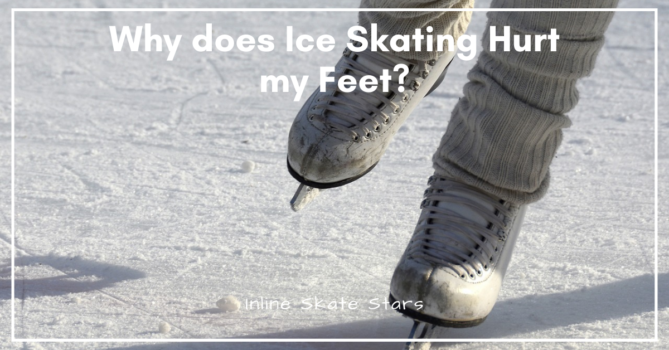Why does ice skating hurt my feet? Figure skating, speed skating, hockey skating, and recreational skating are fun.
The problem is, they can cause writhing pain in your feet, especially when you’re still new.
Usually, the feet pain when and after ice skating is caused by one or more reasons like;
- Ill-fitting ice skates
- Not using the right ice skating gear like socks
- A medical condition affecting the ankles like pronation and supination
- Overuse injury from overskating
- Weak Foot Muscles
- Poor ice skating techniques
- Fall injuries like broken ankles
Why Ice Skating Is Hurting your Feet {and How to Make it Stop}
But this is only the scratch on the surface. In the rest of this guide, I cover in detail the possible reasons your feet hurt when and after ice skating.
You don’t want to miss out on this. So, I urge you to read on to the end. That being said, let’s get to it!
1. Ill-fitting Ice Skates
Ill-fitting ice skates are either too tight or too loose, causing lace bites or your feet wobbling.
Lace bite pain is felt at the lower leg between the ankle joint and the end of your shins.
If the pain is coming from this area, it could be a lace bite, also known as a tongue bite.
Lace bite pain is usually progressive and caused by too-tight ice skates.
The more you wear your ice skates, the more they hurt because of pressure from the skate laces and skate tongue.
So, first, you need to check that you’re not tightening your laces.
Lace bite pain is characterized by swelling, redness, and writhing pain when you touch the front part of your ankle.
Apart from tying your laces too tight, the lace bite can also be caused by new pair of skates, wearing old or inexpensive skates, and muscle soreness.
The best way to handle lace bite pain is to rest until the pain goes away. You can also ice your ankles to reduce the pain.
Lastly, you can take over-the-counter pain relievers like ibuprofen (Advil) and naproxen sodium (Aleve).
The most reliable way to prevent the problem is by wearing the right-fitting ice skating shoes.
The best-fitting ice skating shoes should snuggly fit your feet—neither too tight nor too loose.
Best Ice Skates for men, women, and kids. Please check them out on Inline Skates!
- K2 F.I.T. ICE PRO ICE SKATES
- RIEDELL EMERALD FIGURE SKATES
- RIEDELL 133 DIAMOND FIGURE SKATES
- K2 ALEXIS PRO ICE SKATES – WOMENS
- RIEDELL 133 TS FIGURE SKATES – WOMENS
- RIEDELL MOTION FIGURE SKATES – WOMENS
- RIEDELL FLAIR FIGURE SKATES – WOMENS
- RIEDELL J FIGURE SKATES – GIRLS
- RIEDELL 15 J GR4 PLUS FIGURE SKATES – KIDS
2. Not using the Right Ice Skating Gear like Socks
When you’re in action at the indoor or outdoor ice skating rinks, there’s friction between your feet and the ice skating shoes.
This too much rubbing can cause painful blisters on your feet, especially when you skate for significantly more extended periods.
By all means, you want to wear the right socks for ice skating, which are neither too thick nor too thin.
The right socks help to reduce the rubbing between your feet and your ice skates. If your feet hurt when ice skating, you’re probably not using socks, or, not wearing the recommended socks for ice skating.
More Reading: What to Wear Ice Skating Indoors {10 Essential Wears}
3. Medical Condition Affecting the Ankles like Pronation and Supination
The typical medical conditions associated with the ankles and feet are pronation and supination.
Pronation is when your feet bend inwards when wearing ice skating shoes. On the other hand, supination is when your feet bend outwards when wearing your skates.
These two are medical conditions that can cause pain around the ankles. The best way to know for sure you have them is to seek medical attention.
The doctor should be able to diagnose the problem and offer appropriate treatment.
4. Overuse Injury from OverSkating
Overuse injuries are mainly caused by overskating. Skating more than is necessary causes muscle soreness around the ankles and the feet.
Skating is fun, and I get it that you want to skate more often.
However, it would be best if you skated moderately. It’s not cool to experience pain in your feet after having fun ice skating.
So, you want to reduce your frequency of ice skating. For example, if you skate five hours a day, you can lower it to three or four hours.
Do this for a while, then assess the situation. If the pain goes away, there you have your answer.
But if it doesn’t, the pain could be due to other reasons I’ve covered in this write-up.
5. Weak Foot Muscles
Sometimes, your foot muscles aren’t used to ice skating, especially when you’re starting.
Weak foot muscles need time to adjust or get used to the rigorous nature of ice skating. You only need to be a little patient with yourself.
After skating for a while, usually four to six weeks, your feet muscles should be acquainted with ice skating.
More reading: What Muscles does Ice Skating Work?
6. Poor Ice Skating Techniques
Poor ice skating techniques exert too much pressure on your ankle muscles and joints. This is mainly caused by too much bodyweight concentrating around this area.
So, you want to make sure you’re using the recommended skating techniques.
But what is the recommended skating techniques? You’re probably asking. The correct posture when ice skating is bending low, knees above your toes, and shoulders over hips.
This helps transfer your body weight to your toe balls and away from the ankles and ankle joints.
7. Fall Injuries like Broken Ankles
Falling is inevitable because ice skating rinks are slippery, and ice skates can be hard to balance, especially when starting to skate.
So from time to time, you’re likely to fall. Unfortunately, if you don’t fall correctly, you can hurt your ankles and feet.
Surprisingly, the pain may not be instant. However, the more you skate, you’re likely to feel it.
Preventing fall injuries can be tricky. Nonetheless, you can practice the proper falling techniques to protect yourself from fall injuries like broken ankles.
Why does Ice Skating Hurt my Feet | Commonly Asked Questions
1. Should Ice Skates be Tight or Loose?
Ice skates should be neither too tight nor loose. Instead, they should be a snug fit.
The space around your feet and the skates should be at least ½ inch to allow room for foot movement. In addition, they should be 1.0-1.5 size smaller than your street shoes.
2. Is Ice Skating Bad for Feet?
Ice skating can be bad for your feet when you don’t use the correct skating techniques or use the right gear like socks and adequately fitting ice skates.
These can result in lace bites, blisters, pronation, and supination, which hurt pretty bad.
3. How do I stop my Feet from Hurting when Ice Skating?
The best way to stop your feet from hurting when ice skating is by using correctly fitting ice skating shoes, wearing pair of socks when ice skating, avoiding the urge to over skate and doing feet and ankle exercises to strengthen your weak ankles and foot muscles.
Why does Ice Skating Hurt my Feet?| Wrapping Up
Why does ice skating hurt my feet, you ask? Your feet can hurt after ice skating because of one or more reasons. Below is the quick rundown.
- Ill-fitting ice skates
- Not using the right ice skating gear like socks
- A medical condition affecting the ankles like pronation and supination
- Overuse injury from overskating
- Weak Foot Muscles
- Poor ice skating techniques
- Fall injuries like broken ankles
Hope you found this guide helpful. Lastly, take the necessary caution when ice skating to help prevent your feet from hurting.
Most importantly, you should see a doctor when the pain persists.




